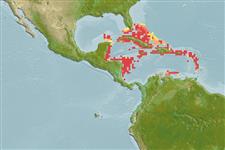Environment: milieu / climate zone / depth range / distribution range
นิเวศวิทยา
เกี่ยวกับทะเล,น้ำเค็ม สัตว์น้ำหน้าดิน; ระดับความลึก 1 - 27 m (Ref. 26268). Tropical; 27°N - 10°N, 89°W - 60°W (Ref. 26268)
Western Central Atlantic: Widespread through insular regions of the Caribbean Sea, including Glover's Reef, St. Eustatius, St. Barthelemy, and the French West Indies. Rarely captured along the continental margins of the Caribbean.
Length at first maturity / ขนาด / น้ำหนัก / Age
Maturity: Lm ?, range 3 - ? cm
Max length : 4.3 cm SL เพศผู้/กระเทย; (Ref. 53028); 5.7 cm SL (female)
ก้านครีบอ่อนที่หาง (รวม) : 76 - 77; ก้านครีบอ่อนที่ก้น: 61 - 62. Slender, small; pale with distinct, dark ocellated spots near rear of dorsal and anal fins.
Inhabits sandy substrates, also those submerged beds of aquatic vegetation, in clear shallow waters near coral reefs. Little is known of its biology since its captured infrequently and generally in small numbers; most captures were a single fish (Ref. 26268).
Life cycle and mating behavior
Maturities | การสืบพันธุ์ | Spawnings | Egg(s) | Fecundities | ตัวอ่อน
Böhlke, J.E. and C.C.G. Chaplin, 1993. Fishes of the Bahamas and adjacent tropical waters. 2nd edition. University of Texas Press, Austin. (Ref. 5521)
IUCN Red List Status (Ref. 130435)
Threat to humans
Harmless
Human uses
การประมง: ไม่มีผลประโยชน์
เครื่องมือ
Special reports
Download XML
แหล่งที่มาจากอินเตอร์เน็ต
Estimates based on models
Preferred temperature (Ref.
123201): 26.6 - 28.2, mean 27.4 °C (based on 290 cells).
Phylogenetic diversity index (Ref.
82804): PD
50 = 0.5000 [Uniqueness, from 0.5 = low to 2.0 = high].
Bayesian length-weight: a=0.01445 (0.00647 - 0.03228), b=3.05 (2.85 - 3.25), in cm total length, based on LWR estimates for this (Sub)family-body shape (Ref.
93245).
ระดับชั้นอาหาร (Ref.
69278): 3.2 ±0.4 se; based on size and trophs of closest relatives
ความสามารถในการกลับคืนสู่ปกติ (Ref.
120179): ความสูง, เวลาต่ำสุดที่จะทำให้ประชากรเพิ่มขึ้นเป็น 2 เท่าใช้เวลาน้อยกว่า 15 เดือน (Preliminary K or Fecundity.).
Fishing Vulnerability (Ref.
59153): Low vulnerability (10 of 100).
